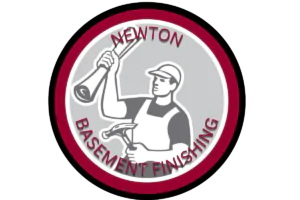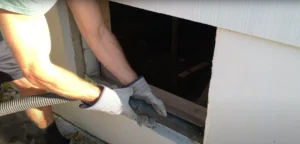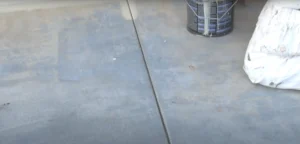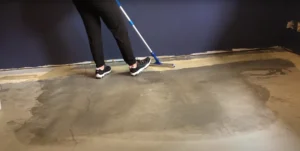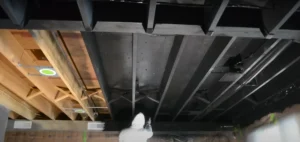Choosing the right insulation for your basement walls is a big deal. It’s all about keeping your home cozy, energy-efficient, and free from moisture problems. Insulation comes in different forms like spray foam, fiberglass, and rigid panels made of materials such as polystyrene or polyisocyanurate.
Each type has its way of working against the cold foundation walls to stop humid air from getting through. The main goal here is not just warmth; it’s also fighting off water vapor that could lead to damp issues.
Foam board stands out because you can use it on both the walls and ceiling, making it a versatile option. Rigid foam is especially good for basins due to its effectiveness in insulating against those chilly outer walls.
Spray foam does more than keep you warm; it acts as an air barrier too. This keeps indoor air away from the cold surfaces in your lower level.
Now, faced EPS takes things up a notch by acting as a vapor obstacle for your cellar walls – and if you tape those seams well, you increase its power even more! When picking what’s best for your space below ground level, think about how well each material keeps heat in, stops moisture, and blocks drafts.
Keeping up with new ways to insulate can help make sure your house stays snug while cutting energy costs over time. Let’s explore these options together!
Key Takeaways
- Foam board insulation keeps basement walls dry and warm by acting as a solid moisture barrier. It’s easy to install on ceilings and walls, making it a great option for enhancing your basement’s energy efficiency.
- Fiberglass insulation is cost-effective and can reduce energy bills by insulating the basement well. Wearing protective gear during installation is important because the fibers can irritate your skin and lungs.
- Spray foam insulation creates a tight seal that prevents damp air from entering, filling gaps and cracks with ease. Despite its higher upfront cost, spray foam significantly improves energy efficiency and moisture control in basements.
Evaluating Insulation Materials for Basement Walls
When selecting insulation materials for basement walls, it’s essential to consider the insulating value, moisture resistance, and ease of installation. These factors play a crucial role in enhancing energy efficiency and preventing water damage in your basement.
Foam Board Insulation
Foam board insulation, made from polystyrene or polyisocyanurate, is a top choice for keeping basement walls dry and energy-efficient. These rigid sheets work well against foundation walls, acting as a solid barrier to moisture and cold.
Homeowners often select this type of insulation because it can be installed on both ceilings and walls in the basement, making it versatile. Its ability to act as a vapor barrier means that with proper sealing at the seams and around edges, water vapor from inside the house has less chance of condensing on cold surfaces within the basement.
Using foam boards also helps minimize thermal bridges – areas where heat escapes more easily – across the basement’s envelope. This improves comfort and cuts down on heating costs during colder months.
I found installing rigid foam paneling straightforward in my own home renovation project; careful cutting ensured a snug fit between wall studs and around obstacles like pipes or wires.
Taping seams securely with specialty tape designed for insulating panels completed the job, sealing off potential entry points for moist air which could lead to damp problems later on.
The improvement was noticeable almost immediately—the previously chilly space felt warmer and stayed drier even without running a dehumidifier constantly.
Fiberglass Insulation
Fiberglass insulation consists of tiny glass fibers and is widely used in basements for its ability to reduce energy costs. Installers fit this material between wood framing, where it acts as both a temperature and sound barrier.
This type of insulation comes in rolls or batts, which makes it easy to install into cavity walls or along the frame of a basement wall. It’s crucial to wear protective gear like N95 masks during installation because the fibers can irritate skin and lungs.
This material also offers flexibility in terms of thickness and density, allowing homeowners to choose the right R-value (a measure of thermal resistance) for their basement’s specific needs.
Adding a vapor barrier on top can prevent moisture from seeping through, making fiberglass batts an effective option for keeping basements dry. While it does not serve as an air barrier by itself, sealing gaps with caulking or spray foam can enhance its effectiveness against leaks and drafts.
Proper installation ensures that fiberglass insulation helps maintain a comfortable temperature in the basement year-round without driving up utility bills.
Spray Foam Insulation
Spray foam insulation acts as a formidable barrier against moisture and outside air, making it an excellent choice for basement walls. This type of insulation fills gaps and cracks with ease, creating a tight seal that can prevent damp air from entering the space.
Its ability to expand and mold itself to the shape of the area it’s applied to ensures that every nook and cranny gets covered. This feature is particularly useful in basements, where uneven surfaces are common.
Using spray foam boosts energy efficiency and helps keep your basement dry by acting as a vapor barrier. Unlike traditional materials that may require additional plastic vapor barriers, spray foam combines insulation with moisture control.
This dual action makes it highly effective in preventing condensation which could lead to mold growth. Furthermore, its solid form once cured adds an extra layer of defense against water intrusion, ensuring your basement remains watertight.
Pros and Cons of Each Insulation Type
Foam board insulation provides good thermal resistance and is easy to install. Fiberglass insulation offers cost-effectiveness and soundproofing properties. Spray foam insulation delivers high R-value and acts as a moisture barrier.
Each type has its advantages, so consider your specific needs when making a decision.
Benefits and drawbacks of Foam Board
Choosing the right insulation for your basement is a key step in upgrading or renovating your home. Foam board insulation stands out for its use in walls and ceilings. This table covers the benefits and drawbacks of using foam board in your basement.
| Benefits of Foam Board | Drawbacks of Foam Board |
| High energy efficiency | Can be more expensive upfront than other options |
| Excellent against moisture | Requires precise installation to avoid gaps |
| Acts as a vapor barrier if using faced EPS | Needs sealing at seams and edges for best performance |
| Useful for both ceilings and walls | Not as strong as some alternatives, can be damaged easily |
| Made of polystyrene or polyisocyanurate | May not fit every basement layout without customization |
Foam board offers an effective way to improve your basement’s energy efficiency and protect it against moisture. It comes in rigid sheets made of materials like polystyrene or polyisocyanurate, which are known for their insulating properties. When installed correctly, with all seams and edges sealed, foam board acts as a solid barrier against the cold and damp, making your basement a more comfortable and energy-efficient space.
Benefits and drawbacks of Fiberglass
Fiberglass is a popular choice for insulating basement walls. This material, made from fine strands of glass, offers both advantages and disadvantages for homeowners looking to improve their basement’s energy efficiency and moisture resistance. Here’s a breakdown in table format to help you understand how fiberglass stacks up as an insulation option for basement renovations.
| Aspect | Benefits | Drawbacks |
| Cost | Generally less expensive than other materials like spray foam | May require professional installation, adding to overall costs |
| Installation | Can be a DIY project for those with some home improvement skills | Fibers can irritate skin and lungs, requiring protective gear during installation |
| Energy Efficiency | Good insulator, helps reduce energy bills by keeping basement walls warmer | Less effective than spray foam in extremely cold climates due to potential for air leaks |
| Moisture Resistance | Does not absorb water, preventing mold growth | Needs a vapor barrier to fully protect against moisture infiltration |
| Durability | Long-lasting with proper installation and maintenance | Can settle over time, reducing its effectiveness if not properly installed |
| Air Barrier | Can be part of an air sealing strategy with careful installation | Not as effective as spray foam as an air barrier |
Fiberglass insulation offers a balance between cost and performance for insulating basement walls. Its affordability and good insulation properties make it a worthy consideration. However, the potential for irritation during installation and the need for a vapor barrier highlight some of the challenges with this material. With careful installation and maintenance, fiberglass can help improve a basement’s energy efficiency and comfort.
Benefits and drawbacks of Spray Foam
Spray foam stands out as a top choice for insulating basement walls. It excels in improving energy efficiency and preventing moisture problems. Here’s a closer approach to understanding its benefits and drawbacks:
| Benefits of Spray Foam Insulation | Drawbacks of Spray Foam Insulation |
| Acts as an effective air barrier | Higher upfront costs compared to other insulation types |
| Improves energy efficiency significantly | Requires professional installation |
| Prevents moisture effectively | Potential for off-gassing shortly after application |
| Adaptable to irregular surfaces and shapes | Not easily removable or adjustable once cured |
Spray foam insulation wraps your basement walls in a seamless layer that keeps the space warm and dry. While it costs more at first, its benefits in energy savings and moisture control are unmatched. Choose spray foam for a snug, efficient basement.
Conclusion: Choosing the Right Insulation for Your Basement
When it comes to insulating your basement walls, the right choice can make a significant impact on energy efficiency and moisture prevention. Foam board insulation offers versatility and ease of installation, while fiberglass provides cost-effectiveness and fire resistance.
On the other hand, spray foam insulation excels in creating an effective air barrier. Each option has its own strengths based on your specific needs, so consider factors such as energy efficiency, moisture prevention, and air barrier effectiveness when making your decision.
FAQs
1. What are the top insulation options for basement walls?
The top insulation options for basement walls include batt insulation, rigid foam insulation, mineral wool insulation, and cellulose insulation. Each offers unique benefits depending on your specific needs.
2. How does each type of basement wall insulation work?
Batt and mineral wool insulations fit between joists in a stud wall or crawl space providing sound dampening properties. Rigid foam and expanded polystyrene offer high R-values (insulation effectiveness), while cellulose is fire-resistant and can be used in attics too.
3. Which type of basement wall insulation has the best R-value?
Rigid foam generally has the highest R-value among these materials, making it an effective choice for insulating basements where temperature regulation is crucial.
4. How do I install different types of insulations?
Installation varies with each material; batts require fastening to studs, rigid foams need a blade for cutting before applying a clear coat, while mineral wool or cellulose will need to be fitted into spaces like floorboards or suspended ceilings.
5. Does waterproofing affect my choice of basement wall Insulation?
Yes! For instance, if you’ve done extensive basement waterproofing that might cause condensation on certain building materials like rigid foams; whereas others like mineral wools allow water to evaporate reducing potential damage.
